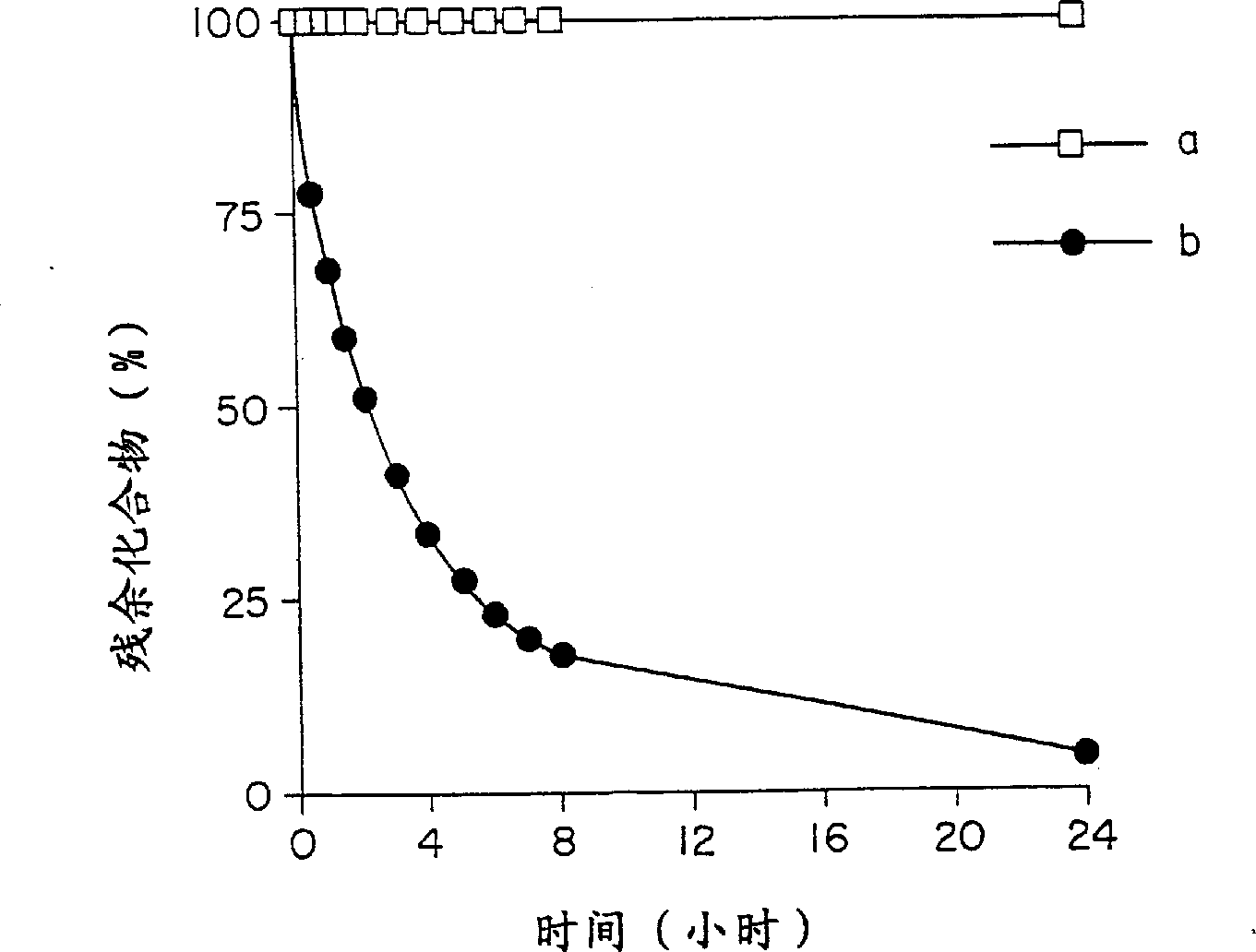Novel tetrahydrobenzindolone derivatives
A compound, hydrogen atom technology, applied in the direction of active ingredients of heterocyclic compounds, organic chemistry, etc.
- Summary
- Abstract
- Description
- Claims
- Application Information
AI Technical Summary
Problems solved by technology
Method used
Image
Examples
Embodiment 2
[0321] The compound prepared in Example 1 (100 mg = 0.36 mmol) was dissolved in acetonitrile (5 ml), to the solution was added acetic acid (200 µl = 3.30 mmol), and the mixture was stirred at room temperature for 20 hr. Dichloromethane (20ml) was added to the reaction solution, the mixture was washed with saturated aqueous sodium bicarbonate (20ml×2) and saturated brine (20ml), and the organic phase was dried over sodium sulfate. The solvent was removed under reduced pressure, and the residue was purified by preparative TLC to give the title compound (85 mg, 74%). 1 H NMR (CDCl 3 )δ1.14(3H, s, 4a-CH 3 ), 1.20 (3H, d, J=7.2Hz, 5-CH 3 ), 1.88 (3H, d, J=2.0Hz, 3-CH 3 ), 1.90 (1H, dq, J=7.2, 2.9Hz, 5-H), 2.06 (3H, s, OCOCH 3 ), 2.16 (1H, br d, J=16.0Hz, 4-H), 2.82 (1H, d, J=16.0Hz, 4-H), 3.10 (3H, s, N-CH 3 ), 3.84 (1H, m, 6-H), 5.20 (1H, dd, J=4.8, 1.7Hz, 7-H), 5.70 (1H, d, J=4.8Hz, 8-H), 5.75 (1H , s, 9-H); MS (EI) m / z 317 (M) + ;[α] 18 D -608 ° (c 1.0, MeOH); mp50-55 °...
Embodiment 3
[0321] The compound prepared in Example 1 (100 mg = 0.36 mmol) was dissolved in acetonitrile (5 ml), to the solution was added acetic acid (200 µl = 3.30 mmol), and the mixture was stirred at room temperature for 20 hr. Dichloromethane (20ml) was added to the reaction solution, the mixture was washed with saturated aqueous sodium bicarbonate (20ml×2) and saturated brine (20ml), and the organic phase was dried over sodium sulfate. The solvent was removed under reduced pressure, and the residue was purified by preparative TLC to give the title compound (85 mg, 74%). 1 H NMR (CDCl 3 )δ1.14(3H, s, 4a-CH 3 ), 1.20 (3H, d, J=7.2Hz, 5-CH 3 ), 1.88 (3H, d, J=2.0Hz, 3-CH 3 ), 1.90 (1H, dq, J=7.2, 2.9Hz, 5-H), 2.06 (3H, s, OCOCH 3 ), 2.16 (1H, br d, J=16.0Hz, 4-H), 2.82 (1H, d, J=16.0Hz, 4-H), 3.10 (3H, s, N-CH 3 ), 3.84 (1H, m, 6-H), 5.20 (1H, dd, J=4.8, 1.7Hz, 7-H), 5.70 (1H, d, J=4.8Hz, 8-H), 5.75 (1H , s, 9-H); MS (EI) m / z 317 (M) + ;[α] 18 D -608 ° (c 1.0, MeOH); mp50-55 °...
Embodiment 5
[0323] In the same manner as in Example, the compound prepared in Example 2 (10 mg=0.03 mmol) was dissolved in pyridine (1 ml), 2-furoyl chloride (9 μl=0.09 mmol) was added to the solution, and the mixture was Stir at room temperature for 15 hours. Dichloromethane (20ml) was added to the reaction solution, the mixture was washed with saturated aqueous sodium bicarbonate solution (20ml×2) and saturated brine (20ml), and the solvent was removed under reduced pressure. The organic phase was dried over sodium sulfate. The residue was purified by preparative TLC to give the title compound (6 mg, 49%). 1 H NMR (CDCl 3 ) δ1.15 (3H, d, J=7.2Hz, 5-CH 3 ), 1.21 (3H, s, 4a-CH 3 ), 1.89 (3H, d, J=1.9Hz, 3-CH 3 ), 2.07 (3H, s, OCOCH 3 ), 2.20 (1H, dq, J=7.2, 2.8Hz, 5-H), 2.21 (1H, br d, J=15.9Hz, 4-H), 2.86 (1H, d, J=15.9Hz, 4-H H), 3.11 (3H, s, N-CH 3 ), 5.26 (1H, dd, J = 4.7, 1.6Hz, 7-H), 5.29 (1H, m, 6-H), 5.76 (1H, s, 9-H), 5.80 (1H, d, J = 4.7Hz, 8-H), 6.49(1H, dd, J=3.5, 1.7...
PUM
 Login to View More
Login to View More Abstract
Description
Claims
Application Information
 Login to View More
Login to View More - R&D
- Intellectual Property
- Life Sciences
- Materials
- Tech Scout
- Unparalleled Data Quality
- Higher Quality Content
- 60% Fewer Hallucinations
Browse by: Latest US Patents, China's latest patents, Technical Efficacy Thesaurus, Application Domain, Technology Topic, Popular Technical Reports.
© 2025 PatSnap. All rights reserved.Legal|Privacy policy|Modern Slavery Act Transparency Statement|Sitemap|About US| Contact US: help@patsnap.com


